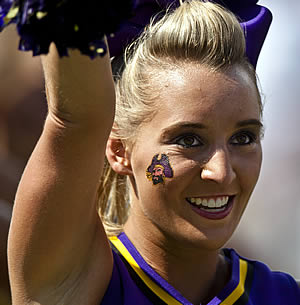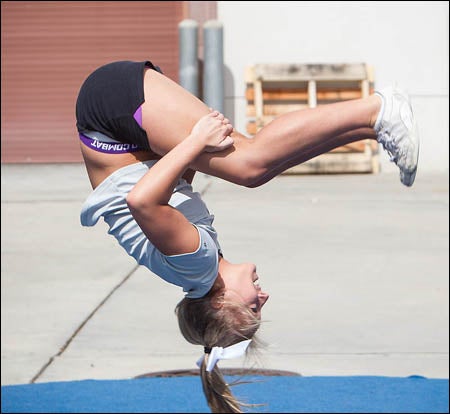Cheerleader bounces back from heart surgery
When East Carolina University cheerleader Alexis Sullivan somersaults across the sidelines at Pirate football games, there’s no hint of what she’s been through the past year.
The sophomore from Greensboro has bounced back from minimally invasive mitral valve repair surgery performed Dec. 16 by Dr. W. Randolph Chitwood Jr., ECU professor of cardiovascular sciences, director of the East Carolina Heart Institute and robotic surgery pioneer.

ECU cheerleader Alexis Sullivan had surgery last fall to repair a leaky mitral valve. Photo by Rob Goldberg Jr., ECU Athletic Media Relations
She resumed reduced training only three months after the surgery, participated in ECU’s bid at the national collegiate cheerleading competition in Daytona Beach, Fla., in April, and has steadily increased her endurance since then.
A dean’s list student and intended social work major, Sullivan earned a spot on ECU’s co-ed cheer team during May tryouts. This summer, she babysat and coached camps with middle and high school cheerleaders while taking a class at North Carolina A&T State University.
Now she’s back to pre-surgery conditioning including 2-mile runs and two-a-day practices and pumping up Pirate fans with round off back handsprings, full twisting layouts, pikes, pyramids and other stunts with her teammates.
The diagnosis
Until last fall, she never had complications from a moderate leak in her mitral valve, the in-flow valve for the left side of the heart that allows blood to flow from the left atrium into the left ventricle. When the valve leaks, blood seeps back into the heart and causes the ventricle to pump more blood. The faulty valve can lead to irregular heart rhythms, shortness of breath and fatigue.
“There are lots of people walking around with a moderate leak, and they don’t have any problems,” said Sullivan, who was diagnosed with a heart murmur at age 1 and had seen a cardiologist every two to three years in her hometown.
An all-star cheerleader, gymnast and competitive summer swimmer from elementary through high school, she cheered without any warning signs when she arrived at ECU.
Every athlete gets an electrocardiogram to be cleared for activity. Sullivan had the test many times because of her heart condition, so it was routine to her. Based on the EKG, the team’s medical staff referred her to ECU cardiologists. She went to the appointment alone, thinking everything would be fine. A follow up EKG and transesophageal echocardiogram confirmed a severe leakage.
“I went thinking I would go in and get out and be fine, because I’ve always been fine,” Sullivan said. “I was in disbelief because it was an all-of-a-sudden-type thing.”
Often physicians follow patients for years before they become symptomatic. Sullivan was unusual; the average age for symptoms to appear is 55, Chitwood said.
“I always knew maybe later on I’d have to have a surgery, but I never thought I’d have to have surgery this young,” Sullivan said. “When they said surgery, everything went upside down.”
‘At ECU for a reason’
She and parents John and Tommie Lynn Sullivan met last Nov. 9 with Chitwood, who has performed more robotic mitral valve surgeries than any other cardiac surgeon in the world and pioneered the procedure at ECU.
“When I found out I was going to have heart surgery, I realized I was put at ECU for a reason,” Sullivan said. “God wanted me to be close to Dr. Chitwood so he could fix my heart.”
Their options were repair or replacement. A replacement would mean she would be on blood thinner and have to limit some activities, not ideal for a vibrant young woman. “A repair is better than replacement,” Chitwood said. “You don’t have to be on a blood thinner, there’s less chance of infection, cardiac function remains good, and it’s just better to have your God-given valve.”
Chitwood explained to the Sullivans how he would use the da Vinci Surgical System to make tiny incisions instead of an 8- to 10-inch incision to break the sternum to access the heart in traditional open-heart surgery.
The smaller incisions would allow robotic arms to be inserted into Sullivan’s chest. One arm would hold a tiny camera to project high-definition, 3-D images onto a monitor in front of Chitwood, who would work at a console away from the operating table. “We call it tele-presence because you’re ensconced, you’re right there walking on the valve,” he said.
The other arms would hold chopstick-like instruments with tiny computerized mechanical “wrists” designed to transmit the dexterity of the surgeon’s forearm and wrist into the chest at the operative site.
“The type of surgery that Alexis had was just ideal for her. Someone like Alexis goes home in four days,” Chitwood said. “But the key piece is they can return to their normal activity.”
The timing of the surgery meant Sullivan would be home for Christmas. Her mother said Sullivan’s ICU nurse, Micah McCanna, an ECU alumnus and baseball player from 2000 to 2004, was a guardian angel, one of many at the East Carolina Heart Institute at Vidant Medical Center who provided extraordinary care for her daughter.
“Alexis was a rarity on our unit,” McCanna said. “We normally do not have healthy individuals, especially athletes, on our unit. I was lucky to have her as a patient and I felt that instant bond because we shared the bond athletes have for one another.”
While young people heal faster, McCanna said, they also have active nerves that can make them extremely sensitive to pain. But less than eight hours after surgery, Sullivan was out of bed sitting in a chair on her last day in ICU before being moved to a step-down unit. “Just as she has always done in her life, she worked hard to get out of that bed,” McCanna said.
A football season ticket holder, McCanna has told everybody in his section “see that girl down there, she dominated heart surgery last year!” McCanna said. “It means a lot knowing I had an impact in her recovery.”
Back on the field
Cheering again was strong motivation, Sullivan said. “Just like any athlete, you want to get back as fast as you can,” she said. “The most positive thing was I was younger and it was easier for my body to recover.”
Her teammates, coaches and professors supported her through pre- and post-surgery appointments and absences.
Cheerleader Madison Keesling, a junior exercise physiology major, could relate. Keesling had months of rehabilitation after surgery in 2010 from a fall that dislocated her left knee cap and tore her anterior cruciate ligament and tibia collateral ligament. Once Sullivan was able, they practiced tumbling skills outside of regular practice.
“I’m amazed at all she’s gone through and come back from,” Keesling said. “People can’t fathom her having heart surgery and how serious it is. I’m very proud of her.”
Susie Hetzler Glynn, head coach of ECU cheerleading and mascots, said the physical demands of the sport often result in knee, ankle or other injuries but Sullivan’s heart surgery was a first for the program. The team rallied around Sullivan as Glynn reassured that her health came first so she wouldn’t worry about missing events.
“They often want to push to get back to cheering, and we have to remind them to be patient and to give their body time to heal,” Glynn said. “Alexis has been amazing. She kept a positive attitude and healed faster than anyone I have witnessed recover from any type of surgery.”
Glynn continues to be amazed by Sullivan’s drive and dedication. “She is participating at 110 percent,” Glynn said.

Sullivan was back training in the spring. Photo by Cliff Hollis, ECU News Services

Sullivan is back to pre-surgery conditioning following heart surgery earlier this year. (Photo by Cliff Hollis)